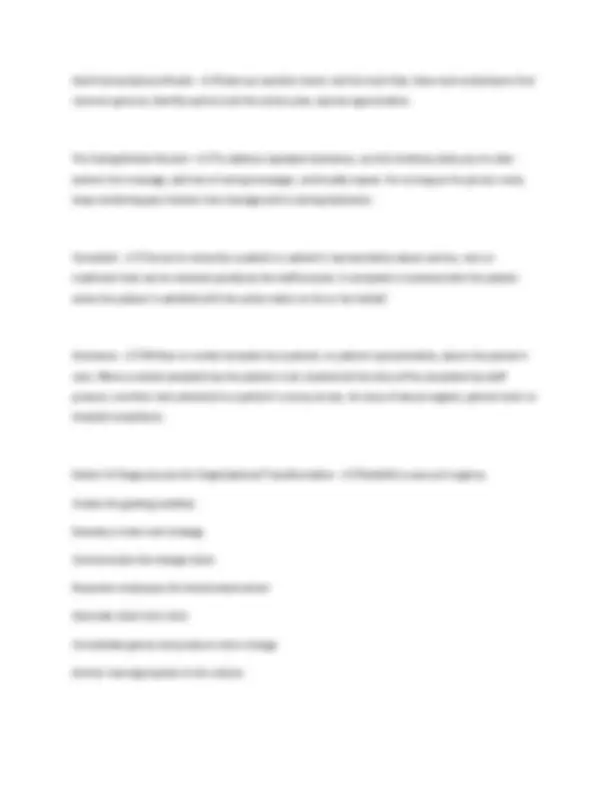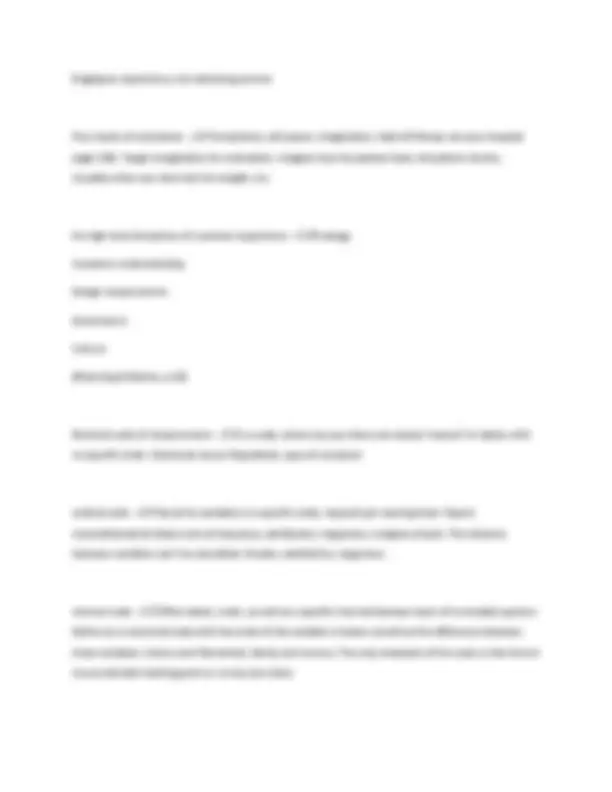















Study with the several resources on Docsity

Earn points by helping other students or get them with a premium plan


Prepare for your exams
Study with the several resources on Docsity

Earn points to download
Earn points by helping other students or get them with a premium plan
Community
Ask the community for help and clear up your study doubts
Discover the best universities in your country according to Docsity users
Free resources
Download our free guides on studying techniques, anxiety management strategies, and thesis advice from Docsity tutors
A comprehensive overview of the key principles, strategies, and tools for enhancing the patient experience in healthcare settings. It covers topics such as the five pillars of excellence, the aidet framework, managing difficult patient behavior, the importance of empathy and communication, various models and approaches (e.g., learn, heart, ask-tell-ask), the role of data and measurement (e.g., hcahps, pareto charts, run charts), and the concepts of patient-centered care, shared decision-making, and health literacy. The document also touches on organizational transformation, process improvement methodologies (e.g., lean, six sigma), and the regulatory landscape surrounding patient experience. By studying this document, healthcare professionals can gain valuable insights and practical strategies to enhance the overall quality of care and improve patient satisfaction and outcomes.
Typology: Exams
1 / 21

This page cannot be seen from the preview
Don't miss anything!














DESK model to counsel a team member - ✔✔D: Describe the problem behavior you have seen E: Explain/ evaulate how the problem behavior affects outcomes and performance( how you feel) S: Show exactly what steps the person needs to take to improve ( behavior you want to see happen) K: Know the consequences (the staff member being corrected) " I have noticed you leave your work space in an inapporiate manner. I'm dissapointed in this and want you to fix it. Let me show you how the space should look lije when you leave for day. This is a verbal warning , if it happens again... then ... Five Pillars of Excellence - ✔✔People Service Quality Finance Growth AIDET - ✔✔Acknowledge (Mr. Smith) Introduce (with experience) Duration (Length of test) Explanation (explain the procedure, Thank patient Managing difficult behavior - ✔✔Maintain adequate space Keep hands out of pocket
Avoid threatening gestures Avoid rapid movements Avoid laughing Be calm Lower volume of voice Speak firmly Use short simple sentences Position self by a safe exit Convey expectations that the patient can control behavior Stay in front but to the side of the patient Demonstrate listening behaviors Let patient vent Be honest Sympathy versus empathy - ✔✔Sympathy is feeling sorry for someone Empathy is walking in someone's else's shoes With empathy and advocate can begin to understand the underlying emotions and pressures Three Rs in a religious diversity - ✔✔Religion: What is the patient's religion. Respect: sacred texts, clothing; Sacramental needs. Resources: chaplain etc.
O-overall hospital rating LEARN - ✔✔Listen Empathize Apologize Resolve Never leave them hanging HEART - ✔✔Hear Empathize Apologize Respond Thank HEART HEAD HEART Model - ✔✔-Start with a caring message. "I am sorry to see you in pain. "
Hard Conversations Model - ✔✔State our positive intent, tell the truth fast, listen and understand, find common ground, identify options and the action plan, express appreciation. The Caring Broken Record - ✔✔To address repeated resistance, use this method; state you're clear bottom line message, add lots of caring messages, continually repeat. For as long as the person resist, keep combining your bottom line message with a caring statement. Complaint - ✔✔Concerns voiced by a patient or patient's representative about service, care or treatment that can be resolved quickly by the staff present. A complaint is resolved with the patient when the patient is satisfied with the action taken on his or her behalf. Grievance - ✔✔Written or verbal complain by a patient, or patient representative, about the patient's care. When a verbal complaint by the patient is not resolved at the time of the complaint by staff present, a written note attached to a patient's survey survey. An issue of abuse neglect, patient harm or hospital compliance. Kotter's 8 Stage process for Organizational Transformation - ✔✔Establish a sense of urgency Create the guiding coalition Develop a vision and strategy Communicate the change vision Empower employees for broad based action Generate short term wins Consolidate games and produce more change Anchor new approaches in the culture
Legitimize-"Most people in your position will feel this way quote. Support.-"I'm going to stick with you through this. " Delivering Diagnosis with ART - ✔✔Ask the patient for his or her perspective about the diagnosis or symptoms. Respond to them with active listening and empathy. Tell your perspective. (Communication R X, page 50) Three Talk Models (shared decision-making ) - ✔✔Team talk: Emphasize supporting patient as you signal choices and elicit goals. Option talk: compare alternatives using Risk communication principles. Decision talk: Elicit preferences and integrate into next steps (Communication RX: page 97)mi Accountabilities drive structure and structure drives - ✔✔Culture (if Disney run your hospital, page 41.) Culture eats strategy for breakfast Improve Efficiencies by.... - ✔✔Placing courtesy and service for us, before efficiency. Next external focus, responsiveness and sharing resources (if Disney ran your hospital, page 42) Cultivate Patient Loyalty - ✔✔Patient satisfaction does not guarantee loyalty. Satisfied customers do not have stories to tell. Build customer loyalty through, compassion and emotion. Spontaneity was described as the ability of frontline employees to solve problems spontaneously on the spot (If Disney ran your hospital, page 106). How to improve the patient experience - ✔✔Create a memorable experience, engage patients on an emotional, physical, intellectual and spiritual level. (If Disney ran your hospital page 111.)
Staging an experience, not delivering service Four levels of motivation - ✔✔Compliance, will power, imagination, habit (If Disney ran your hospital page 134). Target imagination for motivation. Imagine how the patient feels, tell patient stories, visualize when you have lost the weight, etc. Six high level disciplines of customer experience - ✔✔Strategy Customer understanding Design measurement Governance Culture (Manning & Bodine, p.62) Nominal scale of measurement - ✔✔Is a scale, where are you those are simply "named "or labels, with no specific order. Democrat versus Republican, type of computer ordinal scale - ✔✔Has all its variables in a specific order, beyond just naming them. Depict nonmathematical ideas such as frequency, satisfaction, happiness, a degree of pain. The distance between variables can't be calculated. Grades, satisfaction, happiness. interval scale - ✔✔Offers labels, order, as well as a specific interval between each of its variable options. Define as a numerical scale with the order of the variable is known as well as the difference between these variables. Celsius and Fahrenheit, family and income. The only drawback of the scale is that there's no pre-decided starting point or a true zero value
Use Pareto charts when - ✔✔When analyzing data about the frequency of problems or causes in a process, and when you want to focus on the most on the most Significant issues of many. Also, when analyzing broad causes by looking at frequency of components Affinity diagram is - ✔✔A tool that gathers large amounts of the language data: ideas, opinions, issues and organizes them into groupings based on their natural relationships (Viewgraph 1). That affinity process is often used to group ideas generated by brainstorming. (Teams creativity)created 1960 by Japanese anthropologist Jairo Kawakita PDSA - ✔✔Plan-Do-Study-Act DMAIC - ✔✔Define, Measure, Analyze, Improve, Control What is a A3 report - ✔✔One page report use for documenting the necessary information needed for progress reporting and decision making. Some of the items that are usually present in an A3 Report are: Background, current situation, problem, objective, and root cause analysis. Action/improvement items, validation of improvement, follow-up and changes teach back method - ✔✔An educational method used to confirm patient understanding of care instructions by asking patient to repeat the instructions back using their own words HEAT - ✔✔Hear them out Empathize apologize
take responsibility Service recovery - ✔✔The process used to "recovery" dissatisfy or lost members or patients by identifying and fixing the problem or making amends for the failure in customer of clinical service(s). SBAR communication - ✔✔Situation Background Assessment Recommendation Experience Based Design - ✔✔Both a philosophy and set of methods focus on understanding the experiences and emotions of those who are involved in receiving and delivering healthcare services; striving to understand what people naturally feel and do. This approach enables an understanding of the experience of healthcare from the patients, caregivers and staff perspective. It is a method of designing better experiences for patients, families and staff. Experienced Based Co-design (approach) - ✔✔The approach was designed for and with in the NHS to develop simple solutions that offer patients a better experience of treatment and care. However, similar user-centric design techniques have been used by leading global companies for years. Experienced Based Co-Design (Process) - ✔✔Involves gathering experiences from patients and staff through in life and death interviewing, observations and group discussions, identifying key "touch points "(emotionally significant points) and assigning positive or negative feelings.
Exclusive Range - ✔✔highest score minus lowest score Inclusive range - ✔✔Highest score minus the lowest score plus 1 Direct correlation - ✔✔A positive correlation where the values of both variables change in the same direction Reliability - ✔✔The quality of a test such that it is consistent Range - ✔✔The highest minus the lowest score in a gross measure of variability What are the benefits of a run chart? - ✔✔1) They help improve teams formulate Ames by the pick team how well (or poorly)a process is performing
Variance - ✔✔The square of the standard deviation, and another measure of a distribution's spread or dispersion Validity - ✔✔The quality of a chess such that it measures what it says it does LEAN - ✔✔Integrated principles, methods, and tools that have developed from the Toyota production system to optimize the performance and management of value-producing systems. A customer-centric methodology used to continuously improve any process through the elimination of waste in everything you do; it is based on the idea of "continuous incremental improvement "and "respect for people ". What is the principles of LEAN? - ✔✔The basic principles of "LEAN" are focus on effectively delivering value to your customer, respect and engage the people, improve the value stream by eliminating all types of waste, maintain flow, pull through the system, strive for perfection Process flow chart - ✔✔This is a picture of the separate steps of a process and sequential order What are some examples of when to use a flow chart? - ✔✔1) to develop a understanding of how it processes done 2). To study or process for improvement
What are four core concepts of patient and family centered care? - ✔✔Respect and dignity Information sharing Participation Collaboration Patient and family advisory Council (PFAC) - ✔✔This partners patients and families with members of the healthcare team to provide guidance on how to improve the patient and family experience. Information sharing(PFCC) - ✔✔Healthcare practitioners communicate and share complete unbiased information with patients and families in ways that are affirming and useful. Patient and family received timely, complete, and accurate information in order to effectively participate in care and decision- making. Participation (PFCC) - ✔✔Patients and families are encouraged and supported in participating in care and decision-making at the level they choose. Collaboration (PFCC) - ✔✔Patient and families are also included on an institution-wide base. Healthcare leaders collaborate with patients and families in policy and program development, implementation, and evaluation; and healthcare facility design; and in professional education, as well as in the delivery of care. Patient-and family-Center Care - ✔✔An approach to the planning, delivery, and evaluation of healthcare that is grounded in mutually beneficial partnership's among healthcare providers, patients, and families. It redefines the relationship in healthcare.
Empathy - ✔✔The feeling that you understand and share another person's experiences and emotions: the ability to share someone else's feelings. Sympathy - ✔✔The feeling that you care about and are sorry about someone else's trouble, grief, misfortune etc. What are three ways empathy can build relationships and healthcare? - ✔✔1) we can say "I'm sorry "
include self-worth , self-esteem, thoughts, communication, action, values and believes that also guide decision making. Cultural competency - ✔✔Implies having the capacity to function effectively as an individual and an organization within the context of the culture believes, behaviors, and needs presented by the consumer and their communities. Cultural competency - ✔✔Set of congruent behaviors, attitudes and policies that come together in a system, agency, or among professionals that enables affective work in cross-cultural situations. Shared decision making (SDM) - ✔✔Is a collaborative process that allows patients and their providers to make healthcare decisions together. It takes into account the best clinical evidence available, as well as the patient's values and preferences. Transformational Leadership - ✔✔A style of leadership where a leader works with subordinates to identify need to change, creating a vision to guide the change through inspiration, and executing the change in tandem with committed members of a group. Transactional Leadership Style - ✔✔A style of leadership in which leaders promote compliance by followers through both rewards and punishment. It focuses on supervision, organization, and group performance. True or false: grievances about situations that in danger the patients such as neglect or abuse, should be review immediately, given the seriousness of the allegations and the potential of harm to the patient(s).
True or false: a grievance is considered resolve in the hospital is satisfied with the action taken on the patient's behalf. - ✔✔False True or false: Medicare patients have the right to appeal a premature and discharge. - ✔✔True True or false: the hospitals governing body must review and resolve grievances, and less it's delegates this responsibility and writing to a grievance committee. - ✔✔True A complaint - ✔✔Concern voice by patient or patient's representative about service, care or treatment that can be resolved quickly by the staff present. A ————- is considered resolve when the patient is satisfied with the actions taken on his or her behalf. - ✔✔A complaint Grievance - ✔✔a written a verbal complaint (when the verbal complaint about patient care is not resolved at the time of the complaint by staff present) by a patient , or the patient's representative , regarding the patient's care , abuse or neglect , issues related to the hospital compliance with the CMS hospital conditions of participation (CoP), or a Medicare beneficiary billing complaint related to the rights and limitations provided by 42 CFR §489. True or false: if a verbal patient care complaint cannot be resolved at the time of the complaint by staff present, is postpone for later resolution, is referred to other staff or later resolution, requires investigation, and or requires further action for resolution, vent the complaint is a grievance. - ✔✔True True or false: the hospital must establish a process for prompt resolution of patient grievances and must inform each patient whom to contact to file a grievance. - ✔✔True